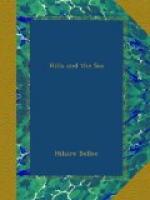For the Valley of the Rother breeds men and is the cause of many delightful villages, all the homes of men. I know that Cobden was born there, the last of the yeomen: I hope that Cobbett lived here too. Manning was here in his short married life; he lived at Barlton (which foolish men call Barlavington), under the old Downs, where the steep woods make a hollow. In this valley also are Fittleworth (the only place in England that rhymes with Little Worth); Duncton, about which there is nothing to be said; Burton, which is very old and has its church right in the grounds of the house; Westburton, where the racehorses were; Graffham, Bignor, Sutton, and I know not how many delightful hamlets.
In the Valley of the River Rother no hurried men ever come, for it leads nowhere. They cross it now and then, and they forget it; but who, unless he be a son or a lover, has really known that plain? It leads nowhere: to the no man’s land, the broken country by Liss. It has in it no curious sight, but only beauty. The rich men in it (and thank Heaven they are few) are of a reticent and homing kind, or (when the worst comes to the worst) they have estates elsewhere, and go north for their pleasure.
Foxes are hunted in the Valley of the Rother, but there are not very many. Pheasants and partridges are shot, but I never heard of great bags; one animal indeed there is in profusion. The rabbit swarms and exults in this life of Southern England. Do you stalk him? He sits and watches you. Do you hunt him with dogs? He thinks it a vast bother about a very little matter. Do you ferret him? He dies, and rejoices to know that so many more will take his place. The rabbit is the sacred emblem of my river, and when we have a symbol, he shall be our symbol. He loves men and eats the things they plant, especially the tender shoots of young trees, wheat, and the choice roots in gardens. He only remains, and is happy all his little life in the valley from which we depart when our boyhood ends.
The Valley of the Rother is made of many parts. There is the chalk of the Southern Down-land, the belt of the loam beneath it; then the curious country of sand, full of dells and dark with pine woods; then the luxurious meadows, which are open and full of cattle, colts, and even sheep; then the woods. It is, in a few miles, a little England. There are also large heaths—larger, you would think, than such a corner of the earth could contain; old elms and oaks; many wide parks; fish ponds; one trout stream and half a score of mills. There are men of many characters, but all happy, honest, good, witty, and hale. And when I have said all I could say of this delightful place (which indeed I think is set apart for the reward of virtue) I should not have given you a tithe of its prosperity and peace and beneficence. There is the picture of the Valley of the River Rother. It flows in a short and happy murmur from the confined hills by Hindhead to the Arun itself; but of the Arun no one could write with any justice except at the expense of far more space and time than I have given me.




